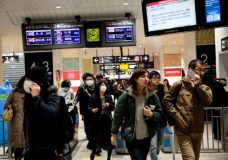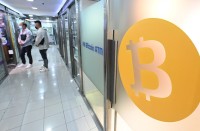
Japanese consumer prices picked up in January 2017 for the first time in almost a year, government data showed on March 3, halting a long string of declines as Tokyo struggles to put deflation in the rear view mirror./ AFP PHOTO /
TOKYO, Japan (AFP) — Japan’s economy expanded by a revised 0.3 percent in the last quarter of 2016, government data showed Wednesday, as company investment and a weaker yen propped up growth.
The latest GDP figure was marginally higher than an initial estimate of 0.2 percent growth in the October-December period, but lower than market expectations for a 0.4 percent expansion.
It marked the fourth straight quarter of expansion in the world’s third-largest economy.
For 2016, the Japanese economy grew 1.0 percent, unchanged from the initial estimate, after posting 1.2 percent growth the previous year, the Cabinet Office said.
Government stimulus measures and capital spending were key growth drivers.
A weak yen also helped prop up the economy by driving exports, but inflation and consumer spending remain weak as cautious firms avoid big pay hikes.
“Private non-residential investment was revised up significantly as we’d expected, and so overall there is little surprise” to the revised figures, said Taro Saito, senior economist at Tokyo’s NLI Research Institute.
“The Japanese economy is on track for moderate recovery and we expect (the Bank of Japan) will keep the current policy for the time being,” he added.
Japan’s economy contracted in the last three months of 2015, before bouncing back last year although the recovery has been wobbly.
That is putting Japanese officials under increasing pressure as more and more economists write off Prime Minister Shinzo Abe’s bid to cement a lasting recovery, dubbed Abenomics.
The plan — a mix of aggressive monetary easing and huge government spending along with reforms to the economy — stoked a stock market rally and fattened corporate profits, but the effect on the wider economy has been less dramatic.
While Japan’s job market is tight, individual spending — which accounts for more than a half of the country’s GDP — has remained in the deep freeze.
The Bank of Japan (BoJ), aiming to create two-percent inflation as part the growth bid, now expects to reach that goal by March 2019 — four years later than planned.
Government and central bank officials have blamed external factors, such as falling energy prices and uncertainty related to emerging economies, for that failure.
Fresh data for this year have been underwhelming so far, with Japan’s factory output unexpectedly slipping 0.8 percent in January, the first fall in six months.
Consumer prices picked up in January for the first time in almost a year, but a 0.1 percent rise in a key inflation index remains way off the BoJ’s target.
© Agence France-Presse







